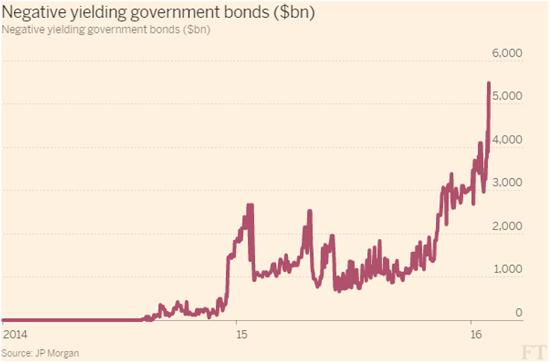Well that didn’t take long. Two weeks of falling share prices and the European and Japanese central banks go into full panic mode. The ECB promised new stimulus — which the markets liked — and then BoJ upped the ante with negative interest rates — which the markets loved. Here’s a quick summary from Bloomberg:
Central Banks Intensify Campaign for Negative Rates
In surprising markets by penalizing a portion of banks’ reserves, the Bank of Japan on Friday joined a growing club taking the once-anathema step of pushing some borrowing costs beneath zero.
“Negative rates are now very much the new normal,” said Gabriel Stein, an economist at Oxford Economics Ltd. in London. “We’ve seen they are possible and we’re going to see more.” Negative rates once “sounded illogical,” said Stein. “We now know what we thought was true isn’t.”
This is a resounding admission of failure. Over the past seven years the world’s central banks have cut interest rates to levels not seen since the Great Depression and flooded their banking systems with newly-created currency, while national governments have borrowed unprecedented sums (in the US case doubling the federal debt). Yet here we are in the early stages of a global deflationary collapse. Commodity prices have followed interest rates to historic lows, while growth is anemic and may soon be nonexistent.
The official response: More extreme versions of what has already failed. Here’s a JP Morgan chart published by Financial Times that shows just how sudden the trend towards negative interest rates has been:
Future historians will have a ball psychoanalyzing the people making these decisions, and their conclusion will almost certainly be some variant of the popular definition of insanity as repeating the same behavior while expecting a different result.
So what does this new stage of the Money Bubble mean? Many, many bad things.
This latest leg down in bond yields presents savers (the forgotten victims of the QE/NIRP experiment) with an even tougher set of choices. Previously they were advised to move out on the risk spectrum by loading up on junk bonds and high-dividend equities. Now, after the past few months’ carnage in those sectors, even the most oblivious retiree is likely to balk. But having said “no thanks” to the demonstrably dangerous options, what’s left? The answer is…very little. There is literally no way remaining for a regular person to generate historically normal levels of low-risk cash on their nest egg.
Meanwhile, a NIRP world presents the US with a problem that perhaps only the Swiss can appreciate: As the other major countries aggressively devalue their currencies (the euro and yen are already down big versus the dollar), another round of lower interest rates and faster money printing will, other things being equal, raise the dollar’s exchange rate even further. For a sense of what that might mean, recall that US corporate profits are already falling because of a too-strong dollar (see Brace for a ‘rare’ recession in corporate profits)
Bump the dollar up another 10% versus the euro, yen and yuan, and US corporate profits might fall off a cliff. The inevitable result: Before the end of the year, the US will see no alternative but to open a new front in the currency war with negative interest rates of its own.
The big banks, meanwhile, are no longer feeling the central bank love. Where falling interest rates used to be good for lenders because they energized borrowers and widened loan spreads, ultra-low rates are making markets more volatile (and thus harder to profitably manipulate for bank trading desks) without bringing attractive new borrowers through the door. The result: falling profits at BofA, JP Morgan, Goldman, et al and tanking big-bank share prices. As the above Bloomberg article notes: “For the banks, this is generally bad news as regards their profitability — with long-term interest rates still lower than before and so margins are squeezed…”
As for gold, there are now $5 trillion of bonds and bank accounts that cost about the same amount to own as bullion stored in a super-safe vault — and which cost more than gold and silver coins stored at home. Compared with the 5%-6% cash flow advantage that bonds have traditionally enjoyed versus gold, NIRP can’t help but lead savers and conservative investors to reconsider their options. In other words, what would you rather trust: A bond issued by a government (Japan, the US, Europe — take your pick) that is more indebted than any government ever and acting ever-more-erratically, or a form of money that has never in three thousand years suffered from inflation or counterparty risk? At some point in the process, a critical mass of people will get this.
And no discussion of the unfolding financial catastrophe would make complete sense if it left out the geopolitical backdrop. The Middle East is on fire and refugees are flooding the developed world, resurrecting old social pathologies (see Swedes storm occupied Stockholm train station, beat migrant children). Much of Latin America is sinking into chaos (see Caracas named as world’s most violent city and 21 of world’s most violent cities are in Brazil). Seeing this, who in their right mind would spend thousands of dollars to visit Egypt or Rio or even Paris right now? The answer is far fewer than a decade ago.
So the old reliable economic drivers of rising global trade and enthusiastic tourism are gone for a while, if not for decades. Central banks are, as a result, swimming against a current that is far faster — in water that is far deeper — than anything seen since at least the 1930s. And all they can do is pump a bit more air into their sadly-inadequate water wings.
